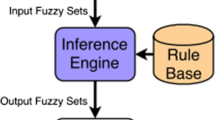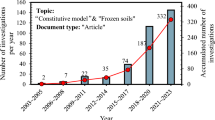Abstract
This paper deals with the numerical solution of fuzzy advection diffusion equation. An algorithm for solving this fuzzy advection diffusion equation using finite difference method has been developed and the new numerical method is named as fuzzy finite difference scheme. The algorithm has been tested by a case study in which the radon transport from subsurface soil into buildings in presence of the fuzziness of the input parameters of advection diffusion equation such as radon diffusion coefficient and flow velocity of radon in air has been presented. Fuzziness of the model parameters is addressed as a fuzzy variable and the membership function of each such fuzzy variable is expressed in the form of a trapezoidal fuzzy number. Explicit finite difference numerical method along with fuzzy parameters of the representative model is applied to obtain the solution of the governing advection diffusion equation. Advantage of this new algorithm is to have the possibility of a power of quantifying uncertainty of the radon concentration as solution of the governing fuzzy partial differential equation. Results of computed radon concentration with uncertainty can be applied further for assessing the uncertainty in health hazards.









Similar content being viewed by others
References
Anderson JD (1995) Computational fluid dynamics. McGraw-Hill, New York
Ayyub BM, Klir GJ (2006) Uncertainty modelling and analysis in engineering and the sciences. Chapman and Hall/CRC Press, Boca Ratan
Chang SL, Zadeh LA (1972) On fuzzy mapping and control. IEEE Trans, Systems Mah Cybemet 2:30–34
Chutia R, Mahanta S, Datta D (2013) Sensitivity analysis of atmospheric dispersion model–RIMPUFF using the Hartley-like measure. J Appl Math Inform 31(1–2):99–110
Cohen BL (1979) Methods for predicting the effectiveness of uranium mill tailings covers. Nucl Instrum Methods 164:595–599
Dubois D, Prade H (1982) Towards fuzzy differential calculus: part 3, differentiation. Fuzzy Sets Syst 8:225–233
Escobar VG, Tome FV, Lozano JC (1999) Proceedings for the determination of 222Rn exhalation and effective 226Ra activity in soil samples. Appl Radiat Isot 50(6):1039–1047
Goetschel R, Voxman W (1988) Elementary fuzzy calculus. Fuzzy Sets Syst 18:31–43
Jiang H, GE L, Lin Y, GU Y (2011) Preliminary study on a reginal radon concentration in surface soil prediction method. Prog Nucl Sci Technol 1:364–367
Kaleva O (1987) Fuzzy differential equations. Fuzzy Sets Syst 24:301–307
Kaleva O (1990) The cauchy problem for fuzzy differential equations. Fuzzy Sets Syst 35:389–396
Klir GJ, Yuan B (1995) Fuzzy sets and fuzzy logic: theory and applications. Prentice Hall, PTR, Upper Saddle River
Kloeden PE (1991) Remarks on Peano-like theorems for fuzzy differential equations. Fuzzy Sets Syst 44:161–163
lelsch G, Ferry C, Tymen G, Robe MC (2002) Study of a predictive methodology for quantification and mapping of the radon-222 exhalation rate. J Environ Radioact 63:15
McKone TE, Bogen KT (1991) Predicting the uncertainties in risk assessment. Environ Sci Technol 25(10):674–1681
Medici F, Rybach L (1994) Measurements of indoor radon concentrations and assessment of radiation exposure. J Appl Geophys 31:153–163
Miles JCH, Appleton JD (2005) Mapping variation in radon potential both between and within geological units. J Radiol Prot 25:257
Moreno V, Baixeras C, Font Li, Bach J (2008) Indoor radon levels and their dynamics in relation with the geological characteristics of La Garrotxa, Spain. Radiat Meas 43:1532
Nazaroff WW, Sextro RG (1989) Technique for measuring the indoor 222Rn source potential of soil. Environ Sci Technol 23(4):451
Puri ML, Ralescu DA (1983) Differentials of fuzzy functions. J Math Anal Appl 91:321–325
Ren T (2001) Source, level and control of indoor radon. Radiat Prot 21(5):291–297
Rogers VC, Nielson KK (1991) Multiphase radon generation and transport in porous materials. Health Phys 60:807
Sasaki T, Gunji Y, lida T (2007) Transient-diffusion measurements of radon: practical interpretation of measured data. J Nucl Sci Technol 44(7):1032–1037
Savović S, Djordjevich A (2008) Numerical solution of the diffusion equation describing the flow of radon through concrete. Appl Radiat Isot 66(4):552–555
Seikkala S (1987) On the fuzzy initial value problem. Fuzzy Sets Syst 24:319–330
Telford WM (1983) Radon mapping in the search for uranium. In: Fitch AA (ed) Developments in geophysical exploration methods, vol 4. Elsevier Barking, Essex, pp 155–194
Uroˇsevic V, Nikezic D (2003) Radon transport through concrete and determination of its diffusion coefficient. Radiat Prot Dosim 104(1):65–70
Zadeh LA (1965) Fuzzy Sets. Inf Control 8:338–353
Author information
Authors and Affiliations
Corresponding author
Rights and permissions
About this article
Cite this article
Datta, D. An algorithm for solving fuzzy advection diffusion equation and its application to transport of radon from soil into buildings. Int J Syst Assur Eng Manag 8 (Suppl 4), 2129–2136 (2017). https://doi.org/10.1007/s13198-014-0319-1
Received:
Published:
Issue Date:
DOI: https://doi.org/10.1007/s13198-014-0319-1




